Chevrolet
Cobalt Front Brake Pads Replacement Guide
How to perform a front brake job on a
2005-2010 General Motors Chevy Cobalt with picture illustrated instructions.
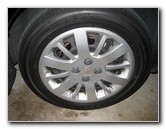 Cobalt Front Wheel |
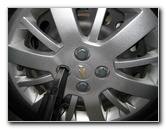 Loosen Plastic Lug Nuts |
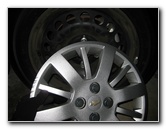 Pull Off Wheel Cover |
| This
automotive "how-to" guide was specifically written to assist owners
of the 2005, 2006, 2007, 2008, 2009 & 2010 Chevrolet Cobalt in replacing the front brake
pads.
Owners of other similar GM vehicles such as the Cruze, Impala, Malibu, Sonic, Lumina, Buick LaCrosse, Regal, Verano, Enclave, GMC Acadia, Yukon, Pontiac Grand Prix, G6, G5, Grand Am, GTO, Vibe, Sunfire, Oldsmobile Alero, Aurora, and Cutlass may also find this guide to be helpful. The following items are needed to complete this front brake job: a floor jack, jack stands, lug nut wrench (tire iron), a 14mm socket with ratcheting wrench, a "C" or "F" clamp, and brake pads. Some compatible aftermarket front brake pads include the following with their respective part numbers: Wagner QC956, Raybestos PGD1160C, ACDelco 14D1160CH, Monroe CX956A, Bendix D956 and Akebono ACT956. |
||
|
|
||
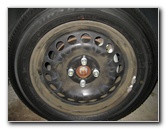 Hub Cab Removed |
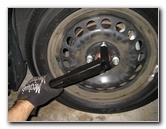 Loosen Four Lug Nuts |
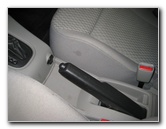 Engage Parking Brake |
| The first two steps
are to engage the emergency parking brake and place
wheel chocks on both sides of the rear
tires to help
prevent the car from moving.
Loosen the four plastic lug nuts that hold the plastic wheel cover in place and then remove it. Slightly loosen the four metal lug nuts behind the wheel cover. Then raise the front of the vehicle with the floor jack, and support it with at least two jack stands. |
||
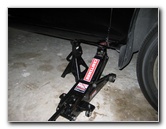 Lift Vehicle |
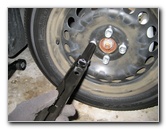 Spin Off Four Lug Nuts |
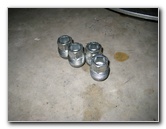 Four Lug Nuts Removed |
| Spin off the four lug nuts the rest of the way and remove the front wheel. Behind the wheel, you'll see the front brake rotor, caliper and caliper bracket. | ||
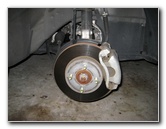 Front Rotor & Caliper |
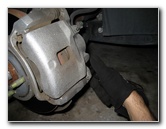 Loosen Lower Caliper Bolt |
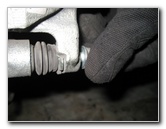 Remove Lower Caliper Bolt |
| To access the front brake pads, remove the lower caliper bolt with a 14mm socket and ratcheting wrench by turning it clockwise (as seen from the outside of the vehicle). | ||
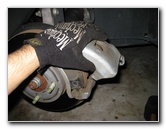 Lift Up Caliper |
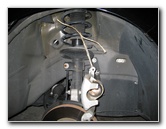 Secure With Twine |
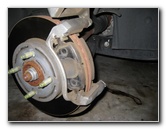 Old Brake Pads Exposed |
| Then swing the
front brake caliper upwards away from the rotor and off the pads.
Support the brake caliper by attaching it to the suspension spring with a piece of twine or rope. This will prevent the caliper from crashing down on your fingers or the rotor while you are replacing the pads. |
||
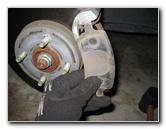 Pull Old Pads Off |
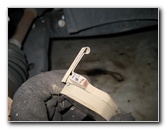 Wear Bar - Top Inner Pad |
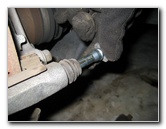 Lubricate Caliper Pins |
| Pull the old front
brake pads off the rotor and out of the caliper bracket.
Make a mental note of where the wear or "squeal" bar is located on the old pads. On this 2010 Cobalt, the wear bar was situated at the top of the inner brake pad. I recommend buying the Wagner ThermoQuiet QC956 brake pads since they have excellent reviews on Amazon. I also like how they don't require any backing plates, shims or disc brake quiet gel due to the built in insulators. If your new brake pads didn't come equipped with wear bars, pull the old wear bar off the existing pads and attach it to the new pads. To help ensure safe and effective braking, both of the caliper pins should be removed and lubricated with a high pressure / temperature moly grease (A.K.A. caliper slider lube). Be sure to gently remove the caliper slider pins from their rubber dust boots so as to avoid damaging them. |
||
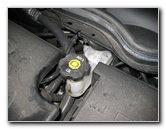 Brake Fluid Reservoir |
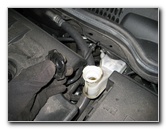 Twist Off Reservoir Cap |
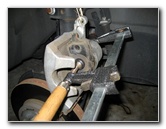 Compress Caliper Piston |
| In order for the
caliper to fit over the thicker new brake pads, the caliper piston will need
to be compressed backwards.
First twist off the cap on the brake fluid reservoir in the engine bay which will allow the fluid to travel more easily through the brake line system. Attach a "C" or "F" clamp to to the caliper using an old brake pad to help evenly spread the force on the piston. Very slowly compress the piston while repeatedly checking the level of brake fluid in the reservoir to prevent it from overflowing. Only compress the caliper piston as far back until it is flush with the rubber dust boot or the metal caliper body. |
||
|
|
||
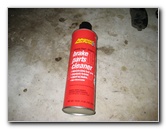 Disc Brake Parts Cleaner |
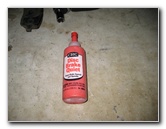 CRC Disc Brake Quiet Gel |
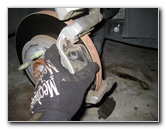 Install New Brake Pads |
| Use some brake parts cleaner spray and a shop
rag to thoroughly clean the brake rotor, caliper and the bracket.
To help prevent braking noise, an optional step is to apply some CRC "Disc Brake Quiet" gel or a similar product to the rear of the brake pads where they come in contact with the caliper. Also apply a bit of the brake caliper grease to the metal edge of the caliper piston. Do not apply anything to the friction surface of the new pads.
|
||
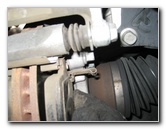 Wear Bar - Top Inner Pad |
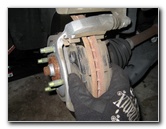 Push Pads Against Rotor |
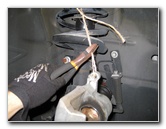 Cut Twine |
| If your new brake
pads came with new metal anti-rattle clips, remove the old ones and install
them on the caliper bracket. Then insert the new brake pads into the caliper bracket with the wear or "squeal" bar situated on the top of the inner brake pad. Push the two new brake pads together until they rest flush against the rotor. |
||
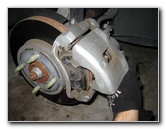 Lower Caliper Over Pads |
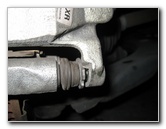 Line Up Caliper & Pin |
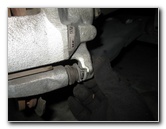 Insert Lower Caliper Bolt |
| Carefully cut the
twine or rope supporting the brake caliper and gently lower it down over the
new brake pads.
If it won't fit, the caliper piston may need to be compressed back a bit more. Line up the caliper pin in the bracket with the bolt hole in the caliper itself. Insert the lower caliper bolt by hand and screw it in a few turns to prevent it from becoming cross threaded. |
||
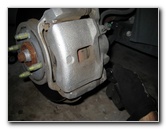 Tighten 14mm Caliper Bolt |
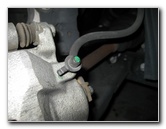 Bleeder Valve Rubber Cap |
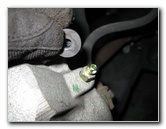 Brake Fluid Bleeder Valve |
| Tighten both the
lower and upper 14mm caliper bolts with the socket and ratcheting wrench to
just past hand tight or about 25 lb ft of torque. If your brake pedal previously felt mushy or spongy, the brake fluid may be contaminated with water or the brake lines may contain air bubbles. It would be best to bleed the brake lines at this time in order to flush out the old fluid and replace it with new DOT 3 brake fluid. For more on this topic, check out my Brake Line Fluid Bleeding DIY Guide. |
||
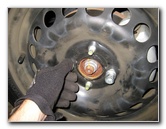 Replace Wheel & Lug Nuts |
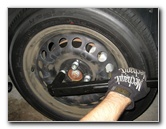 Tighten Nuts With Tire Iron |
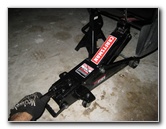 Lower Vehicle |
| Place the wheel
back on the vehicle, spin on the four lug nuts by hand, and slightly tighten
them with the tire iron.
Lower the vehicle from the jack stands and floor jack until the front tire holds enough weight to prevent it from spinning. Then progressively tighten the four lug nuts in a criss cross or star pattern until they are just past hand tight. It would be best to use a torque wrench or an air gun with a torque stick to tighten the lug nuts to about 100 ft lbs of torque. |
||
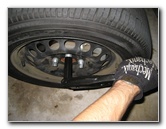 Tighten Four Lug Nuts |
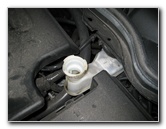 Check Brake Fluid Level |
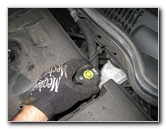 Twist On Brake Fluid Cap |
|
Sit in the driver's seat of the car and pump the brake pedal a few times to restore the brake line pressure. Then check the brake fluid level in the reservoir and verify that it is at the "MAX" (maximum) line. Once the brake fluid level is correct, replace the brake fluid reservoir cap by twisting it on clockwise. To break in your new front brake pads, just drive normally for the first several hundred miles while trying to avoid any hard or "panic" stops which may glaze over the new brake pads and cause them to be noisy and/or not perform as well. It's also a good idea to regularly examine your driveway for drops of brake fluid which may indicate a leak, check the brake fluid level in the reservoir, and also check that the lug nuts are still properly tightened. Be sure to record the brake pad change in your vehicle's service records. For more,
check out my other
Chevy Cobalt Repair & Maintenance Guides. |
||
| If you found this guide to be helpful,
please consider making a small donation by clicking on the PayPal.com
"Donate" button located to the right of this paragraph. Thank you!
(Note: I am not a registered charity. Donations are not tax deductible.) |

